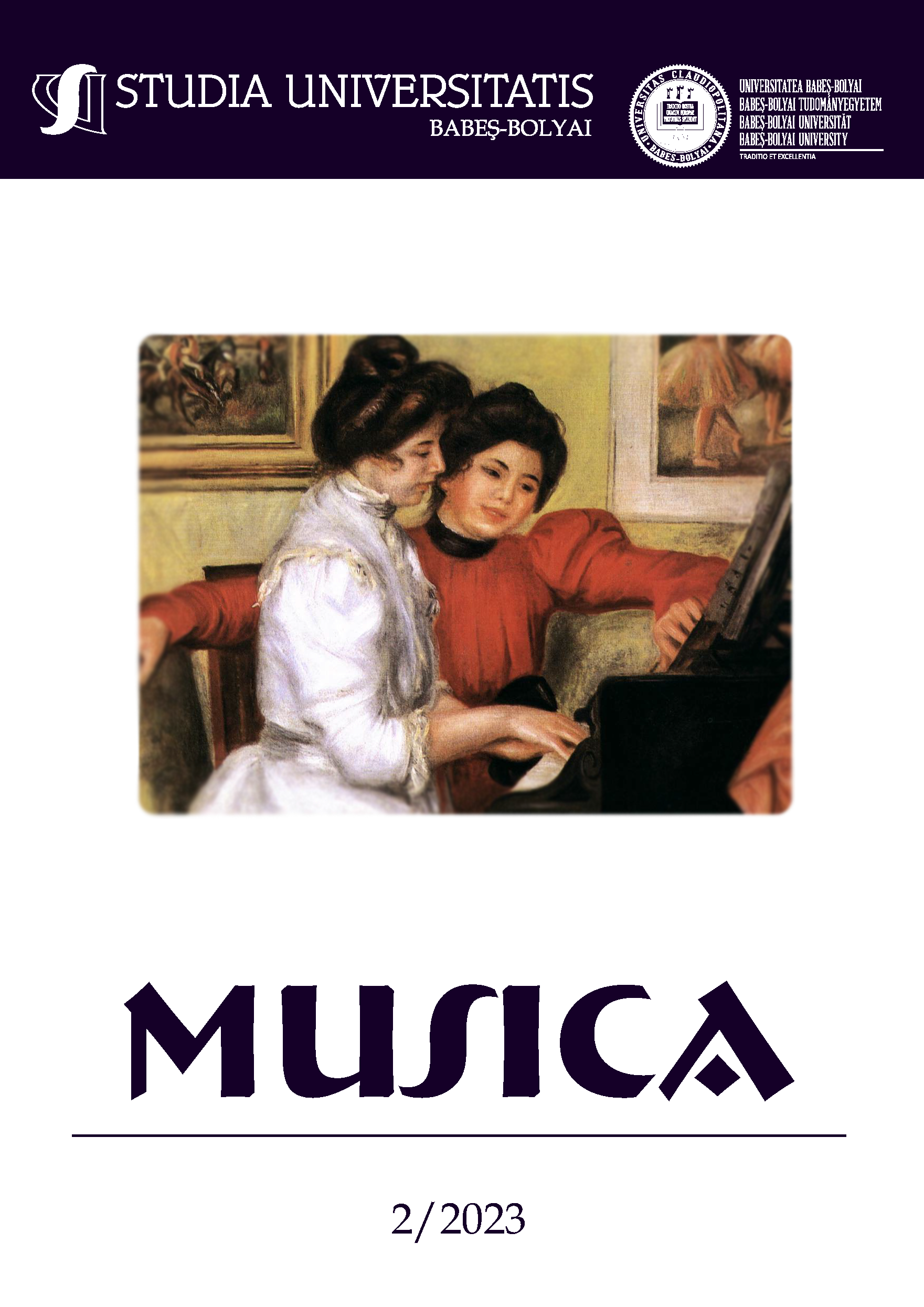Music and the Altered State of Consciousness
DOI:
https://doi.org/10.24193/subbmusica.2023.2.12Keywords:
music, altered state of consciousness, ecstatic dimension, binaural beats, 440 Hz, rhythm.Abstract
Tourists travelling to Turkey may encounter circling (mevlevi) dervishes in Konya, spinning in circles to achieve a kind of altered state of consciousness and enter a trance-like state of ecstasy. The world of popular music has also been inspired by the concepts of Christianity and ecstasy, and some rock bands have emerged from a combination of the two. This altered state of consciousness is brought about by the combined effect of dance and music, which they believe can be an ecstatic experience of dual action, freeing one from the agonies and pains of everyday life. In some religions, the ecstatic and altered state of consciousness is part of ritual and worship as a power unleashed. The question is, is there a place for music-induced ecstasy in Christian worship? In this sub-chapter, we will discuss the ecstatic effect of music, the altered state of consciousness experienced as a result, and the increasingly prevalent binaural beats and music at 432 hertz.References
Alban, Deane. Binaural Beats: A Meditation Shortcut. https://bebrainfit.com/binaural-beats-meditation/ (2023. July 2.).
Bánfalvai, Attila. A szabadság arcai a pszichoanalízisben (The faces of freedom in psychoanalysis). Osiris Publishing House, Budapest, 1998, 1222-139.
Bari, Máriusz. Digitális drogok, végtelen kockázat. (Digital drugs, infinite risk) http://hvg.hu/tudomany/20080403_agyhullam_binauralis_utem (2023. July 2.).
Barnard, Christiaan. 50 Wege zu einem gesunden Herz (50 Ways to a Healthy Heart). ECON Ulstein List Verlag, München, 2000.
Bartha, Tibor (szerk.). Keresztyén bibliai lexicon (Christian Bible Lexicon). Kálvin Publishing House, Budapest, 1993. 336. Az In the Old Testament, the calling of the prophets is called by the “ecstasy” (Isa 6:1k, Jer 1:4k, Ezek 1:1k, Zech 1-6), and in the New Testament, by the baptism of Jesus (Mark 1:10k), the temptation (Mt 4,1kk), the story of the glorification (Mk 9,2kk)”, Peter (Acts 10) and Paul (9,1kk), Stephen (Acts 7,55) and the rapture of John (Mark) are also included in this category in the literature.
Berg, Kathy and Siever, Dave. “A Controlled Comparison of Audio-Visual Entrainment for Treating Seasonal Affective Disorder”. In: Journal of Neurotherapy, 13. 2009/3. 166-175.
Bokor, József (szerk.). A Pallas nagy lexikona (Big Lexicon of Pallas). https://mek.oszk.hu/00000/00060/html/026/pc002628.html#2 (accessed: 2023. July 2.).
Bolyki, László. Milyen zenét szeret Isten? (What kind of music does God like?) Álomgyár Publishing House, Budapest, 2005.
Csepelyi, Adrienn. Verdi a nácik ellen (Verdi against the Nazis). http://nol.hu/kultura/verdi-a-nacik-ellen-1583847 (2023. July 3.).
Détári, László. Biológiai ritmusok. http://slideplayer.hu/slide/2093282/ (accessed: 2023. July 2.).
Forrai, Judit. Erotika és zene, avagy a szex zenéje (Erotica and music, or the music of sex). In: Falus András (szerk.). Zene és egészség, Kossuth Publishing House, Budapest, 2016.
Gál, Péter. A dicsőítés és a keresztény rock zene (Worship and Christian rock music). http://www.karizmatikus.hu/evangelizacio/dicsites-liturgia/2968-a- dicsites-es-a-kereszteny-rock-zene.html (accessed: 2023. July 2.).
Grannum, Gillian. The A=440 Hz Frequency: DNA Tuning and the Bastardization Music. http://www.shiftfrequency.com/curious-case-of-432-vs-440/ (2023. July 3.).
Hézser, Gábor. Pasztorálpszichológiai szempontok az istentisztelet útkereséséhez. Elméleti és gyakorlati lehetőségek (Pastoral-psychological perspectives on the search for worship. Theoretical and practical possibilities). Kálvin János Publishing House, Budapest, 2007.
Horowitz, Leonard G. Musical cult control: The Rockefeller Foundation’s War on consciousness through the imposition of A=440 Hz standard tuning. https://steemit.com/440hzconcertpitch/@tonefreqhz/musical-cult-control- the-rockefeller-foundation-s-war-on-consciousness-through-the-imposition- of-a-440hz-standard-tuning-part-3 (2023. July 3.)
Horváth, Szilárd. Istvan Sky – Az ember, aki zenével gyógyít (Istvan Sky - The man who heals with music). Reportage, Hungarian, 2012.
Kartomi, Margaret J. “Music and trance in central Java”. In: Ethnomusicology, 17. 1973/1. 167.
Marian, Jakub. The 432 Hz vs. 440 Hz conspiracy theory. https://jakubmarian.com/the-432-hz-vs-440-hz-conspiracy-theory/ (2023. July 3.).
Nagy, Gábor – Lovass, Pál. A kábítószerek világa (The world of drugs). Medicina Publishing Hpuse, Budapest, 1985.
Oster, Gerald. Auditory Beats in the Brain. Slow modulations called binaural beats are perceived when tones of different frequency are presented separately to each ear. The sensation may show how certain sounds are processed by the brain. http://www.amadeux.net/sublimen/documenti/G.OsterAuditoryBeatsintheBrain.pdf (accessed 2023. July 2.).
Raghavan, Sandhya. Benefits of binaural beats and how it can heal your mind and body. http://www.thehealthsite.com/diseases-conditions/benefits-of-binaural-beats-and-how-it-can-heal-your-mind-and-body-k0217/ (2017. January 8.).
Scott R., Hutson. The rave: Spiritual healing in modern western subcultures. In: Anthropological Quarterly. Academic Research Library, 73. 2000/1. 35-49.
Stewart, Benjamin. Kymatica. Documentary film, USA, 2009.
Stevenson, August (Ed.). English Oxford Living Dictionaries. https://en.oxforddictionaries.com/definition/ecstasy. February 6.).
Szabó Csaba, Csákó Rita and Nagy Katalin. A zenei élmények mint módosult tudatállapot vizsgálata és összehasonlítása a transzállapot egyéb formáival (Examining musical experiences as an altered state of consciousness and comparing them with other forms of trance state). http://real.mtak.hu/1055/1/43394_ZJ1.pdf (2017. February 2.).
Székely, Csilla Imola. “Rítus, ritmus, zene és lélek” (Ritual, rhythm, music and soul). In: Falus, András (szerk.): Zene és egészség, Kossuth Publishing House, Budapest, 2016.
The Free Dictionary by Farlex. http://www.thefreedictionary.com/ecstasy (2023. July 2.).
Travis, Fred. Minden meditáció egyforma? A Mindfulness, a Tibeti Buddhizmus és a TM (Are all meditations the same? Mindfulness, Tibetan Buddhism and TM). https://www.tminfo.hu/tudomanyos-tudatkutatas/minden-meditacio-egyforma-a-mindfulness-a-tibeti buddhizmus-es-a-tm/ (2017. January 19.).
Wilson-Dickson, Andrew. The Story of Christian Music. A Lion Book, Oxford – Batavia – Sydney, 1992.
Wilson, Lawrence. Trance States – a Way to understand many People. http://drlwilson.com/Articles/TRANCE%20STATES.htm (2023. July 2.).
Downloads
Published
How to Cite
Issue
Section
License
Copyright (c) 2023 Studia Universitatis Babeș-Bolyai Musica

This work is licensed under a Creative Commons Attribution-NonCommercial-NoDerivatives 4.0 International License.






